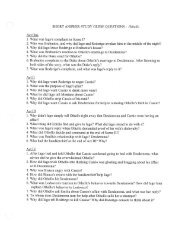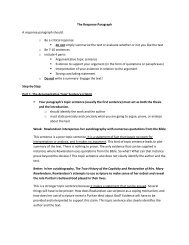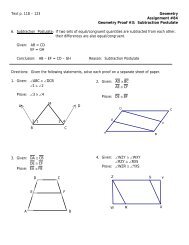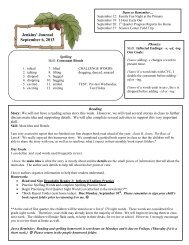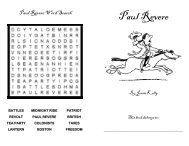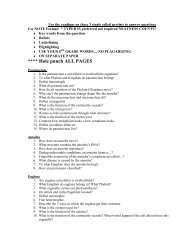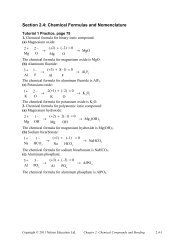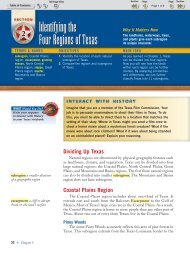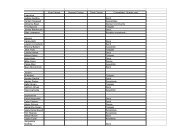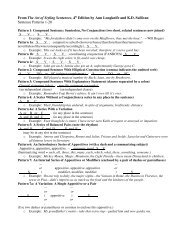Ch. 12 Practice test
Ch. 12 Practice test
Ch. 12 Practice test
Create successful ePaper yourself
Turn your PDF publications into a flip-book with our unique Google optimized e-Paper software.
AP European History<br />
Mr. Castañón<br />
<strong>Ch</strong>. <strong>12</strong>: Age of Religious Wars<br />
Multiple <strong>Ch</strong>oice<br />
Identify the choice that best completes the statement or answers the question.<br />
1. A ruler who is known as a politique<br />
A) rules with an iron fist.<br />
B) works well with Parliament.<br />
C) adopts <strong>Ch</strong>ristian humanism.<br />
D) places political unity of the country above religion and personal beliefs.<br />
E) practices international diplomacy.<br />
2. The Huguenots were<br />
A) a majority of the population of Europe.<br />
B) mainly from the lower classes.<br />
C) Dutch Jansenists.<br />
D) English Catholics.<br />
E) French Calvinists.<br />
3. The French Civil War, between Catholics and Huguenots, involved which of the following families<br />
A) Habsburg, Guise, and Bourbons<br />
B) Valois, Guise, and Bourbons<br />
C) Valois, Tudor, and Bourbons<br />
D) Stuart, Tudor, and Guise<br />
E) Guise, Valois, and Habsburg<br />
4. The Saint Bartholomew’s Day Massacre in 1572 was an attack on<br />
A) French Huguenots.<br />
B) German peasants.<br />
C) the wealthy of Paris.<br />
D) Dutch merchants.<br />
E) Italian laborers.<br />
5. Which individual was directly involved in the events of the French Civil War?<br />
A) Mary Queen of Scots<br />
B) Mary Tudor<br />
C) Catherine de Medici<br />
D) Catherine of Aragon<br />
E) Elizabeth I<br />
6. France was saved from religious anarchy and constant civil war when religious principles were set aside for<br />
political necessity by King<br />
A) Henry II.<br />
B) Francis I.<br />
C) Louis XIV.<br />
D) Henry IV of Navarre.<br />
E) <strong>Ch</strong>arles IX.<br />
1
Age of Religious Wars AP European History Mr. Castañón<br />
7. The Edict of Nantes was one of the Henry IV’s most significant acts of his reign because of all the following<br />
reasons EXCEPT<br />
A) it was one of the first governmental guarantees of religious freedom in Europe<br />
B) it granted Huguenots civil and political equality with Catholics<br />
C) it continued the bitter civil war between Catholics and Pro<strong>test</strong>ants<br />
D) it brought peace to France<br />
E) it granted Huguenots political control of many towns in France<br />
8. Which of the following was not a pillar of Spanish power under Philip II?<br />
A) riches from the New World<br />
B) the unification of Spain through Pro<strong>test</strong>antism<br />
C) an increase in population<br />
D) supremacy in the western Mediterranean<br />
E) an efficient bureaucracy and military<br />
9. Spanish dreams of a world empire were undermined by<br />
A) the revolt of Portugal.<br />
B) the revolt of the Netherlands.<br />
C) uprisings among the Spanish nobility.<br />
D) the emergence of a Spanish Pro<strong>test</strong>ant movement.<br />
E) the lack of strong beliefs among Spain’s leaders.<br />
10. The Netherlands revolted again Spanish rule for all of the following reason except<br />
A) Dutch nationalism<br />
B) High taxes placed on the Netherlands by Spain<br />
C) Netherlands wanted religious freedom from Spain<br />
D) Spain was assisting a planned English invasion of the Netherlands<br />
E) Spain was controlling and suppressing Dutch trade<br />
11. Which of the following was a reason Queen Elizabeth I decided to aid the United Provinces in their war<br />
against Spain in the 1580s?<br />
A) The war in the Netherlands could strengthen the English economy.<br />
B) England was interested in invading the United Provinces.<br />
C) The English feared the spread of Pro<strong>test</strong>antism through the region.<br />
D) The English feared a Spanish invasion of their island.<br />
E) The English monarchy wanted to acquire Habsburg territory.<br />
<strong>12</strong>. What significant event weakened the Spanish dominance in Europe, from which Spain never fully recovered?<br />
A) the assassination of Henry IV<br />
B) the English conquest of Spanish colonies in the Americas<br />
C) the assassination of Henry III<br />
D) the St. Bartholomew’s Day Massacre<br />
E) the defeat of the Spanish Armada<br />
13. The inflation of the sixteenth century was the result of<br />
A) the influx of wealth from the New World.<br />
B) the influx of wealth from the New World and increased population.<br />
C) an overheated industrial sector of the early modern economy.<br />
D) the discovery of new deposits of gold and silver in Europe.<br />
E) increased population.<br />
2
Age of Religious Wars AP European History Mr. Castañón<br />
14. Between 1618 and 1648, the Thirty Years’ War involved<br />
A) virtually every major European country<br />
B) primarily nations in southern Europe<br />
C) only religious factions in Britain<br />
D) only the 360 political provinces that comprised Germany<br />
E) only nations south of Denmark<br />
15. Which of the following was NOT a phase of the Thirty Years’ War?<br />
A) The French Period<br />
B) The Danish Period<br />
C) The Bohemian Period<br />
D) The Dutch Period<br />
E) The Swedish Period<br />
16. In the Thirty Years’ War, France supported the German Pro<strong>test</strong>ants in order to<br />
A) gain financial support from Sweden.<br />
B) help the Netherlands achieve their independence.<br />
C) promote the spread of Calvinism across Europe.<br />
D) take over the Holy Roman Empire for France<br />
E) defeat the Habsburgs in Spain and Germany.<br />
17. The Peace of Westphalia, which ended the Thirty Years’ War,<br />
A) further strengthened the Holy Roman Empire.<br />
B) was a great victory for Catholicism.<br />
C) maintained that only Catholicism and Lutheranism were legitimate religions.<br />
D) completely weakened the Holy Roman Empire.<br />
E) refused to recognize the independence of the United Provinces of the Netherlands.<br />
18. After the Peace of Westphalia in 1648, which country emerged as Europe’s dominant country<br />
A) Spain<br />
B) France<br />
C) Sweden<br />
D) Germany<br />
E) Austria<br />
19. Which was the result of the Thirty Years’ War?<br />
A) Germany replaced Austria as the predominant power in Central Europe.<br />
B) The Habsburg reign ended in Austria.<br />
C) The Holy Roman Empire was politically and economically devastated and its<br />
population decimated.<br />
D) The French lost all influence in German affairs.<br />
E) Sweden was victorious in all phases of the conflict.<br />
20. The Peace of Westphalia did all of the following except<br />
A) ended all hostilities with the Holy Roman Empire<br />
B) gave Calvinists legal recognition of their religion<br />
C) gave Switzerland and the Netherlands their independence<br />
D) helped to unify the provinces of the Holy Roman Empire<br />
E) reasserted the major features of the Peace of Augsburg<br />
3



